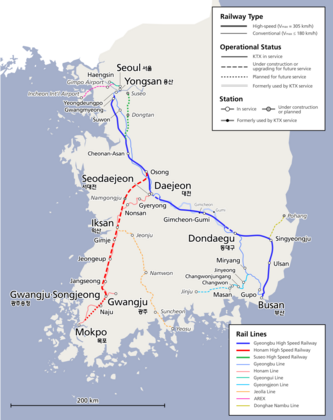By train
HomeBy train

KTX network map
National train operator Korail connects major cities in South Korea. Neglected for a long time, a large amount of money has been plowed into the network in recent years and trains are now quite competitive with buses on speed and price, and much safer and more comfortable to boot. The main problem is that the network is still a little limited and services in rural areas are limited, with trains only once every few hours.
Particularly useful are the high-speed Korea Train eXpress (KTX) services between Seoul and Busan via Daegu, Daejeon and often Ulsan, which use French TGV technology to zip along at up to 300 km/h. The fastest non-stop trains cover the distance in just over two hours. The KTX trains have 18 cars with the first 3 being first class and the rest reserved economy seating except the very last car (number 18) which is open seating. There are drink vending machines on board and an attendant that comes by with a snack cart which includes reasonably priced beer, soda, cookies, candy, sausages, hardboiled eggs, and kimbap (rice rolls).
Seoul to Busan by train |
||
Type |
Time |
Price |
KTX |
2:08 |
W55,500 |
Saemaeul |
4:45 |
W41,100 |
Mugunghwa |
5:30 |
W26,500 |
All prices off-peak (Mon-Thu), small surcharges apply for peak (Fri-Sun) |
||
Non-KTX trains are poetically ranked as Saemaeul (새마을, "New Village"), Mugunghwa (무궁화, "Rose of Sharon") and Tonggeun (통근), corresponding roughly to express, semi-express and local services. Saemaeul trains are a little pricier than buses, while Mugunghwa are about 30% cheaper. However Saemaeul trains are extremely comfortable, having seats that are comparable to business class seats on airplanes. Though with the introduction of the KTX, there are much fewer Saemaeul and Mugunghwa services, they are worth trying them out. Tonggeun, formerly Tonggil, are cheapest of all, but long-distance, non-aircon services have been phased out and they're now limited to short stopping commuter services. Most longer-distance trains have an entertainment car with a small cafe/bar, computers with internet access (W500 for 15 minutes) and a few trains even have private compartments with coin-operated karaoke machines!
Smoking is not permitted on any Korean trains or stations (including open platforms).
Seoul also has an extensive commuter train network that smoothly interoperates with the massive subway system, and Busan, Daejeon, Daegu, Gwangju and Incheon also have subway services.
Tickets are much cheaper than in Japan but more expensive than other Asian countries - although the damage can be lowered by travelling on local trains rather than KTX. Buying tickets is fairly easy - self-service terminals accepting cash and credit cards are in multiple languages and are very simple to use. Station staff can usually speak basic English. Most stations are clean, modern and have good signposting in Korean and English, and compared to China or Japan, Korea's rail system is very user-friendly.
Pre-booking any train tickets a day prior (be they KTX or mugunghwa) is recommended for weekend trips, as all trains can be booked out for hours on end. On Sunday in particular, all but local trains have begun to completely book out regularly. Failure to reserve tickets in advance when departing busy hubs such as Seoul or Busan may see your options reduced to "unallocated seating" on the slowest local trains (sitting on the floor in the unairconditioned space between carriages, or standing in the toilet for much of the trip. You are, however, free to sit on any seat that seems free until someone with the ticket to that seat shows up. If you are confident in your Korean, you can ask to reserve seats on sections that are available and travel standing up the rest of the way.).
See Also |